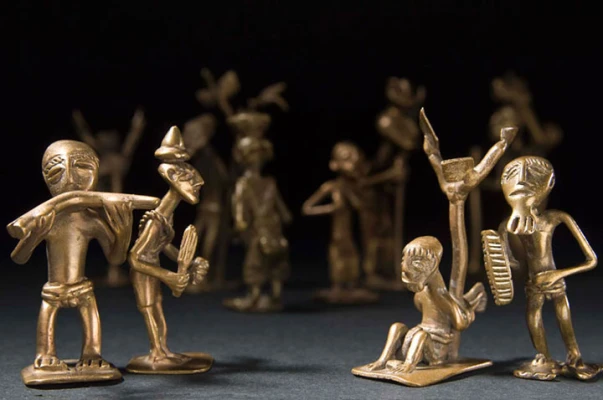Anglogold Ashanti: Ghanaian Gold...
May 17, 2024

Akan goldweights, locally known as mrammou or abrammuo, are brass weights used by the Akan people of West Africa for weighing gold and ensuring fair trade.
Owning a complete set of weights elevated a man's social status significantly, and small sets of weights were often gifted to newlywed men to help them enter the merchant trade with respectability and success.
Beyond their practical application, Akan goldweights are miniature representations of West African cultural items such as adinkra symbols, plants, animals, and people. These intricate designs reflect the rich cultural heritage and artistic traditions of the Akan people.
Goldweights can be stylistically dated into two broad periods: the early period (1400–1720 AD) and the late period (1700–1900 AD). Geometric weights, the oldest forms, date back to 1400 AD, while figurative weights, depicting people, animals, and buildings, first appeared around 1600 AD. It's estimated that around four million goldweights were cast by the Ashanti and Baule ethnic groups of West Africa between 1400 and 1900 AD.
Radiocarbon dating is not applicable to goldweights since they are made of inorganic materials. Instead, studying the cultural background or provenance of the weights provides accurate dating. Historical records and comparative studies with the oral and artistic traditions of neighboring communities are essential to understanding the origins and significance of these weights.
Scholars use goldweights and the oral traditions behind them to understand aspects of Akan culture that might otherwise be lost. The weights represent stories, riddles, and codes of conduct, guiding the Akan peoples in their daily lives. Central to Akan culture is the concern for equality and justice, expressed through these weights as symbols of personal behavior codes, beliefs, and values.
The names, writing, and philosophy ingrained in these weights are unique to the Akan people. While different cultures inevitably influence each other, the ideas embedded in these weights are primarily native to the Akan people.
There are parallels between Akan goldweights and the seals used in Harappa. Both artifacts stabilized regional and local trade while acquiring meaning beyond their practical uses. Interestingly, while many animals and shapes are depicted in goldweights, the lion is notably absent. The leopard, thriving in the forested areas of the Ashanti region, is the prominent motif, symbolizing strength and courage, unlike the European heraldic lion.
It's estimated that around three million goldweights exist today. Notable collections can be found in the National Museum of Ghana, the Musée des Civilisations de Côte d'Ivoire, the Derby Museum, and various smaller museums in Mali. Simon Fraser University also has a collection, consisting mostly of geometric and human figurative weights.
Each weight was meticulously carved and cast using the ancient technique of lost wax. As the Akan economy moved away from using gold, the cultural significance of the weights diminished, and they became popular tourist items, often mass-produced. Modern weights lack the refined artistic features of traditional weights, but they remain popular souvenirs.
Goldweights were crafted with great precision, with most weights being within 3% of their theoretical value. Adjustments were made to ensure accuracy, demonstrating the skill of the goldsmiths. Early weights featured bold, simple designs, while later weights evolved into detailed works of art. However, by the 1890s, the quality of both design and material had declined, leading to the abandonment of the weights.
May 17, 2024
May 8, 2024
May 13, 2024
February 16, 2024